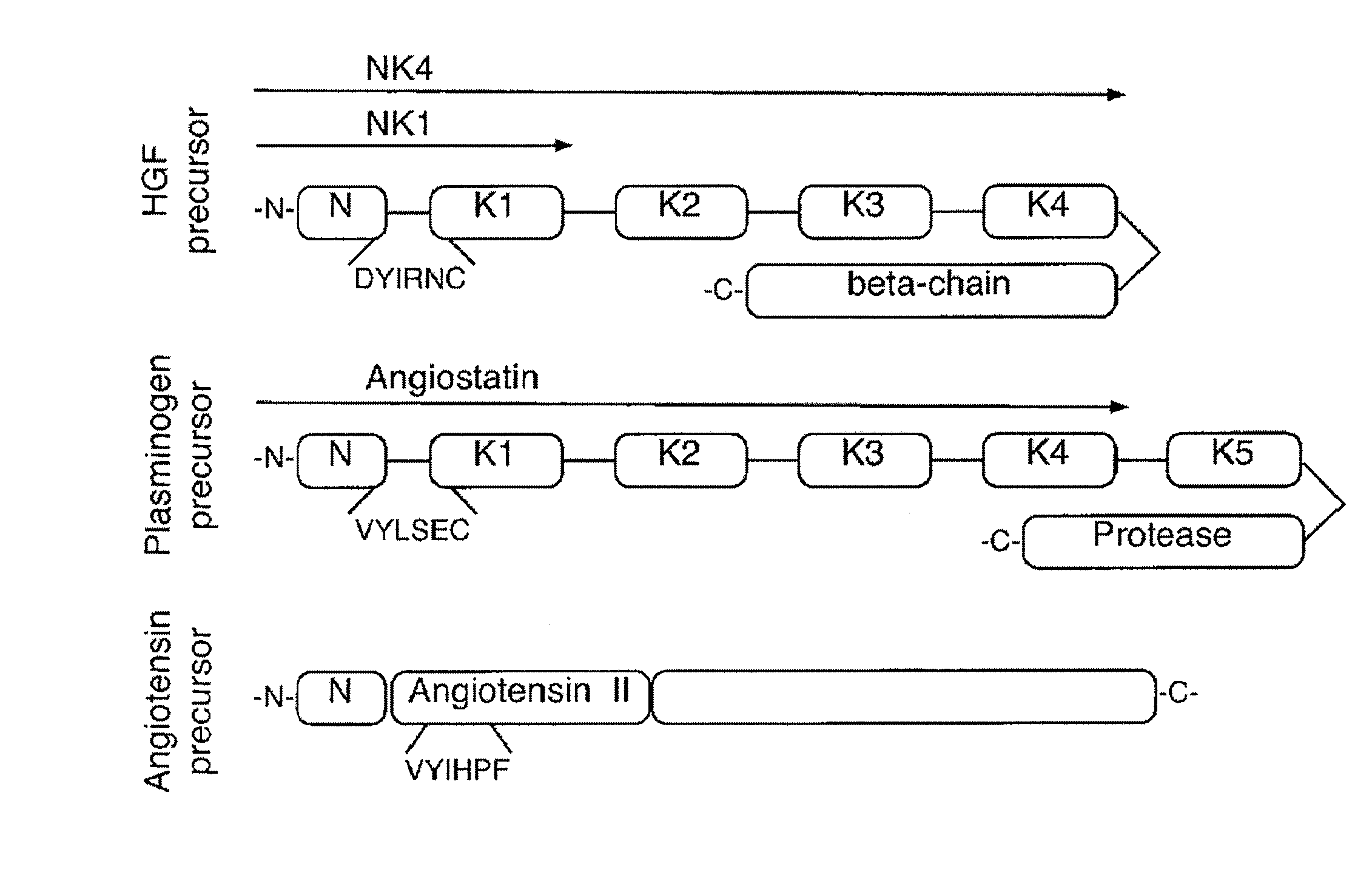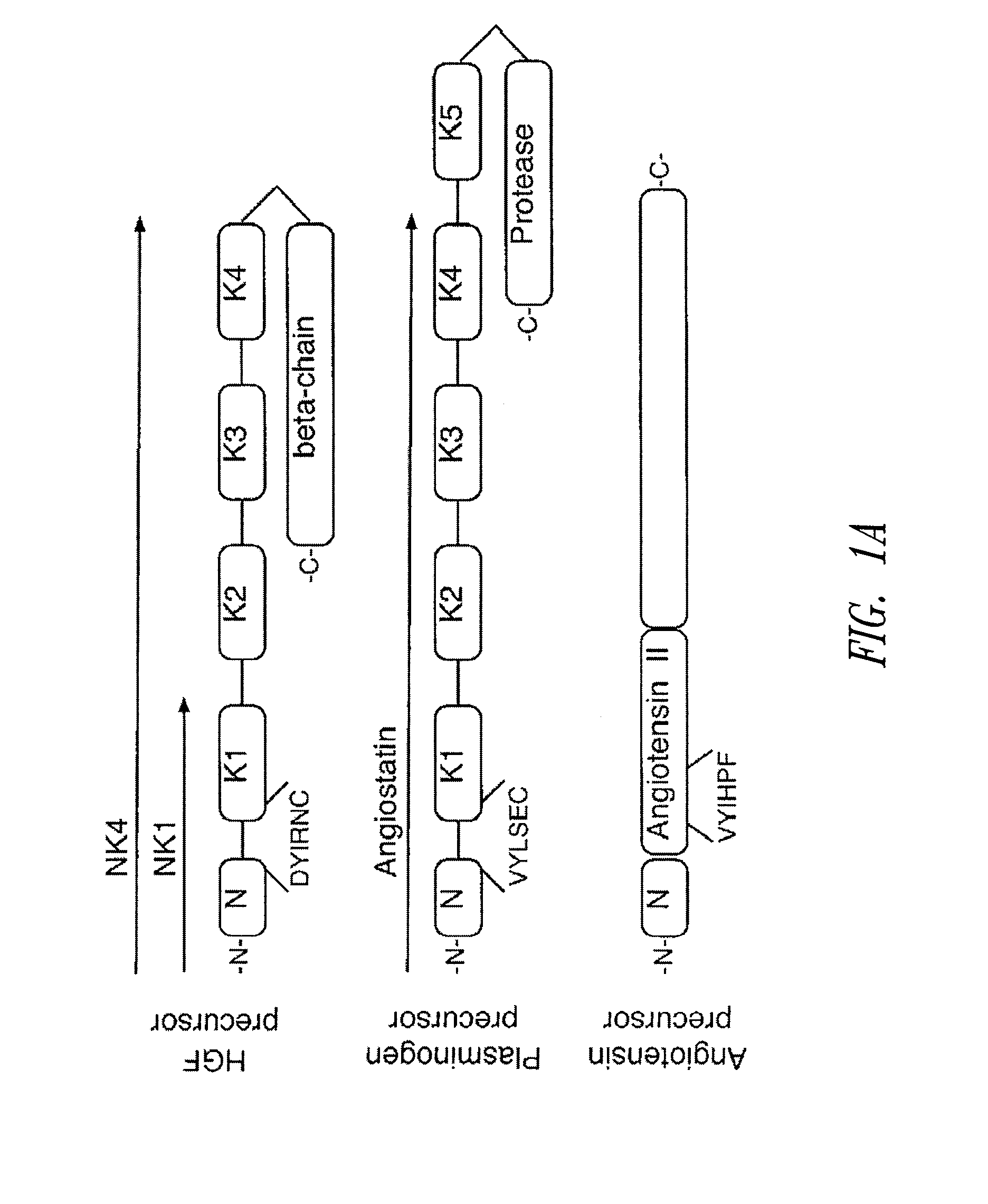C-met receptor regulation by angiotensin iv (AT4) receptor ligands
a technology of c-met receptor and angiotensin iv, which is applied in the field of altering hepatocyte growth factor activity or c-met receptor activity, can solve the problems of difficult reconciliation, elusive molecular identity of the target at4 /sub>receptor that mediates a number of at4 biological activities, and certain health conditions
- Summary
- Abstract
- Description
- Claims
- Application Information
AI Technical Summary
Benefits of technology
Problems solved by technology
Method used
Image
Examples
example 1
Materials and Methods
[0231]This Example describes materials and methods used in the Examples that follow and also in the generation of data for FIGS. 1-19; additional detail regarding experimental procedures and results can be found above under “Brief Description of the Drawings”.
[0232]Compounds. Norleual (Compound 2, SEQ ID NO:43) was synthesized by Syngene (Bangalore, India) and purified by reverse phase HPLC. HGF (SEQ ID NO:83) was purchased from R&D systems (Minneapolis, Minn., USA).
[0233]Antibodies. Antibodies specific for c-Met (SEQ ID NO:84), Gab1, and phospho-tyrosine were purchased from Upstate Biotechnology Inc. (Lake Placid, N.Y., USA). Anti-phospho-tyrosine, HAM1676, was purchased from R&D systems. Phospho-Akt- and Erk-specific antibodies were purchased from Cell Signaling (Danvers, Mass., USA). GAPDH-specific antibody was purchased from Biodesign (Saco, Me., USA).
[0234]Cell culture. Cell lines HEK293, MDCK, B16-F0 and B16-F10 (all available from ATCC, Manassas, Va.) wer...
example 2
The Angiotensin-Like Factor Norleual Competes with HGF for Binding to the c-Met Receptor
[0245]This Example shows that the AT4 receptor antagonist, Norleual (Compound 2, SEQ ID NO:43, [Nle-Y-L-ψ-(CH2—NH2)—H—P—F], Davis et al., 2006 Neuroscience. 137: 1369) competed with HGF for binding to c-Met on cell surfaces and in a cell membrane. Materials and methods were as described in Example 1. In separate tests of unlabeled competitors, both Norleual and HGF competed with 125I-HGF for high affinity binding to mouse liver plasma membranes (FIGS. 2A, 2B). The IC50 values for Norleual and HGF were 3.1±2.1 pM and 29.4±14.7 pM (mean ±SEM, n=3), respectively; the latter value was similar to that reported previously (Higuchi et al. 1991 Biochem. Biophys. Res. Commun. 176: 599-607). To further test the hypothesis that Norleual interacted with the c-Met system, 125I-Norleual was bound to HEK293 cell membranes alone or in the presence of HGF or Norleual. Both ligands competed for 125I-Norleual speci...
example 3
Inhibition of HGF-Induced Cell Scattering by an Angiotensin-Like Factor
[0247]To explore the physiological significance of the angiotensin-like factor Norleual's ability to depress c-Met signaling, Norleual's effect on HGF induced cell scattering of Madin-Darby canine kidney (MDCK) cells was assessed with the coverslip assay (Miao et al., 2003 J. Cell Biol. 162: 1281-1292). See Example 1 for other Materials and Methods. Norleual inhibited HGF-induced MDCK cell scattering, yielding a response that was similar to controls (FIG. 8A).
PUM
| Property | Measurement | Unit |
|---|---|---|
| Fraction | aaaaa | aaaaa |
| Digital information | aaaaa | aaaaa |
| Electrical resistance | aaaaa | aaaaa |
Abstract
Description
Claims
Application Information
 Login to View More
Login to View More - R&D
- Intellectual Property
- Life Sciences
- Materials
- Tech Scout
- Unparalleled Data Quality
- Higher Quality Content
- 60% Fewer Hallucinations
Browse by: Latest US Patents, China's latest patents, Technical Efficacy Thesaurus, Application Domain, Technology Topic, Popular Technical Reports.
© 2025 PatSnap. All rights reserved.Legal|Privacy policy|Modern Slavery Act Transparency Statement|Sitemap|About US| Contact US: help@patsnap.com



